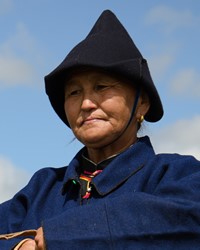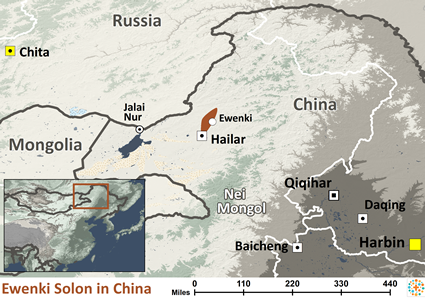The Ewenki are believed to be descended from the Shiwei people who lived in the mountains northeast of Lake Baikal in Siberia. By the early 1600s, groups of Ewenki started to migrate into China, spreading along the tributaries of the lower Amur River.
The name Ewenki means "mountain forest people." It was coined by the Russians earlier in this century to describe the nomads in eastern Siberia. The name Solon means "those (people) from the upper course of the river."
The Solon Ewenki language is labeled the Haila'er dialect of Ewenki by the Chinese. It is mutually unintelligible with the other three Ewenki varieties. The Solon Ewenki are said to be able to understand 70% of the Oroqen language. Many can also speak Daur.
The Solon Ewenki are the largest of the four Ewenki groups in China. They account for approximately 80% of all Ewenki in China, which amounts to more than 21,000 of the total 1990 census figure of 26,300 for the Ewenki nationality. The Ewenki are also found in Russia and Mongolia. They have survived for centuries in the harsh temperatures of north Asian winters. The Solon Ewenki primarily inhabit the Morindawa, Oroqen, and Arong Banners in the eastern part of Inner Mongolia. There they live alongside Mongols, Daur, and Oroqen. It is a beautiful region, with more than 600 lakes and freshwater springs located among the pasture lands and woods of the Greater Hinggan Mountains. A small number of Solon Ewenki also live in Nehe County in Heilongjiang.
Most Solon Ewenki families earn their livelihood by fishing, raising reindeer, and hunting. Many still live in yurts that are easy to assemble and transport from place to place. This is a necessity of life for the Ewenki. Many stay in one place no more than ten days in the summer. In the winter they may move as often as every two days. The Ewenki practice the same burial rites as the Oroqen. Corpses are wrapped in birch bark and hoisted up a tree to decompose naturally.
The primary religious belief among the Solon Ewenki is shamanism, although some who have been influenced by the Mongolians have adopted the Tibetan Buddhist religion. The Solon Ewenki also worship the spirits of their ancestors. They pray to many gods and deities, asking for success in hunting.
Although there are a small number of Ewenki Eastern Orthodox believers in China, they are all among the Tungus Ewenki group in the Chenbaehru region. There are no known Christians or churches among the Solon Ewenki in China. In Russia the Ewenki were forced to convert to Orthodox Christianity in the sixteenth and seventeenth centuries However, their conversion appears to have been largely superficial. They continued to worship spirits; they also included statues of Jesus among their idols.
Without the guidance of Christ, these people will be spiritually lost in this life and the life to come. They need someone to go to them as Christ-bearers.
Pray for the Lord to intervene in their families, calling people to his side.
Pray for loving, anointed workers.
Pray for their hearts to be drawn to the Lord of lords.
Pray for a church planting movement to thrive in their communities.
Scripture Prayers for the Evenki, Solon in China.
Operation China, Asia Harvest, Copyrighted © Used with permission
| Profile Source: Joshua Project |

























